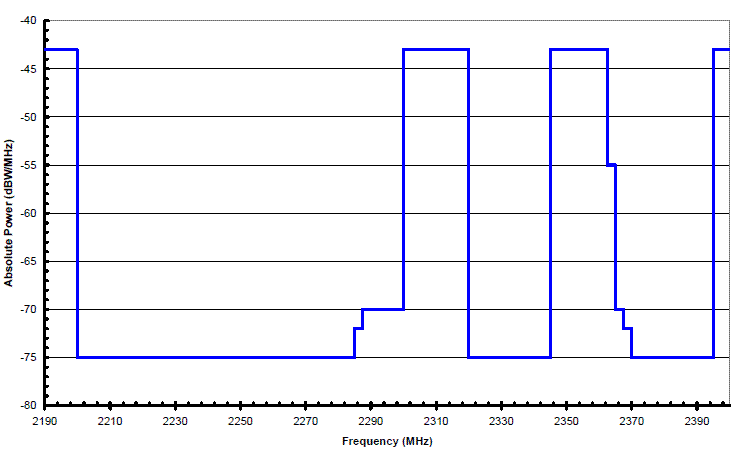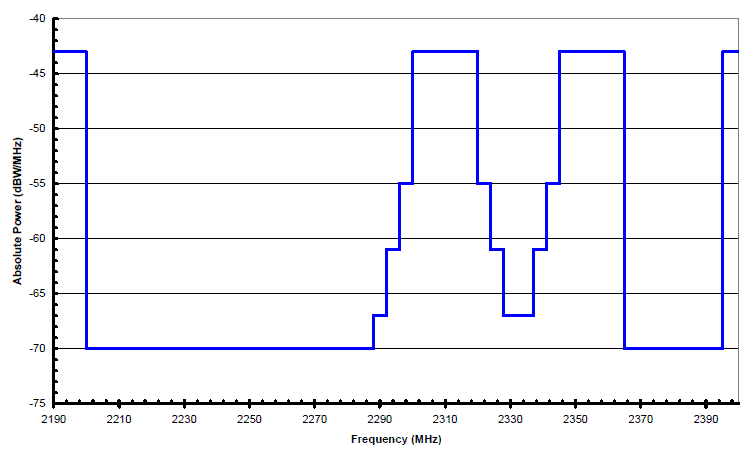Issue 2
Radio Standards Specification
Posted on Industry Canada website: April 24, 2014
Preface
Radio Standards Specification RSS-195, Issue 2, Wireless Communications Service (WCS) Equipment Operating in the Bands 2305‑2320 MHz and 2345-2360 MHz, replaces Issue 1 of RSS-195, dated January 2004.
This document will be in force as of the publication date of Notice SMSE -006-14 in the Canada Gazette, Part I. Upon publication, the public has 120 days to submit comments. These comments will be taken into account in the preparation of the next version of the document.
Listed below are the changes:
- The requirement that RSS-Gen shall be used in conjunction with this RSS is stated.
- Material common to most Radio Standards Specifications has been moved to RSS-Gen.
- Definitions of equipment types have been added.
- Peak to average power ratio (PAPR) for base and fixed station equipment in the frequency ranges 2305‑2315 MHz and 2350-2360 MHz has been added.
- Fixed subscriber equipment is classified into low-power and high-power devices with different unwanted emission limits.
- The transmitter unwanted emission and power limits have been modified.
- The requirement for receiver standard spurious emissions has been withdrawn as a result of decisions announced in Regulatory Standards Notice 2012-DRS0126.
Issued under the authority of
the Minister of Industry
Marc Dupuis
Director General
Engineering, Planning and Standards Branch
1. Scope
This Radio Standard Specification (RSS) sets out certification requirements for radio transmitters and receivers of Wireless Communication Service (WCS) systems operating in the bands 2305-2320 MHz and 2345-2360 MHz. WCS systems are used for the provision of local broadband access services in mobile, point-to-point and point-to-multipoint configurations.
2. General Information
Equipment covered by this standard is classified as Category I equipment and a technical acceptance certificate (TAC), issued by the Certification and Engineering Bureau of Industry Canada, or a certificate, issued by a recognized Certification Body (CB), is required.
2.1 Licensing Requirements
The equipment covered by this standard is subject to licensing pursuant to subsection 4(1) of the Radiocommunication Act.
2.2 Related Documents
All Spectrum Management and Telecommunications publications are available on the departmental website at http://www.ic.gc.ca/spectrum, under Official Publications.
The following document should be consulted:
SRSP
-516
Technical Requirements for Wireless Communication Service Operating in the Bands 2305-2320 MHz and 2345-2360 MHz
SRSP — Standard Radio System Plan
2.3 Definitions
Base Station Equipment is fixed equipment which is designed for communicating with subscriber equipment.
Fixed Station Equipment is fixed equipment which provides point-to-point connection between two fixed points.
Fixed Subscriber Equipment is fixed equipment which provides connectivity between the user’s equipment and base station equipment.
High-Power Fixed Subscriber Equipment is fixed subscriber equipment having an equivalent isotropically radiated power greater than 2 W per 5 MHz with the transmitted power measured in average value.
Low-Power Fixed Subscriber Equipment is fixed subscriber equipment having an equivalent isotropically radiated power less than or equal to 2W per 5 MHz with the transmitted power measured in average value.
Mobile Subscriber Equipment is subscriber equipment designed to be used while in motion and/or during halts at unspecified points.
Portable Subscriber Equipment is subscriber equipment designed to be used within 20 cm of the user’s body, e.g. hand-held devices, laptops, etc.
3. General Requirements
3.1 RSS-Gen Compliance
RSS-195 shall be used in conjunction with RSS-Gen, General Requirements and Information for the Certification of Radio Apparatus, for general specifications and information relevant to the equipment for which this standard applies.
4. Measurement Methods
4.1 Transmitter Output Power
For base and fixed station equipment transmitting in the bands 2305-2315 MHz or 2350-2360 MHz, the transmitter output power shall be measured in average value. For base and fixed station equipment transmitting in the bands 2315-2320 MHz or 2345-2350 MHz, the transmitter output power shall be measured in peak value.
For fixed subscriber equipment, the transmitter output power shall be measured in peak value. However, in order to determine the classification of low- and high-power fixed subscriber equipment (see Section 2.3), the transmitter output power shall be measured in average value.
For mobile and portable equipment, the transmitter output power shall be measured in average value.
4.2 Transmitter Unwanted Emissions
The equipment shall be tested for compliance with the unwanted emissions limit with the equipment set to transmit at the lowest and highest channels, in each of the frequency bands 2305-2320 MHz and 2345‑2360 MHz in which the equipment is designed to operate.
If the transmitter is designed for a multi-carrier operation, the test shall be carried out using the maximum number of carriers intended for the equipment.
5. Transmitter and Receiver Standard Specifications
5.1 Automatic Transmit Power Control
Mobile, portable and fixed subscriber equipment shall employ automatic transmit power control when operating so that the equipment shall operate with minimum power necessary for successful communication.
5.2 Frequency Plan
The frequency plan, including frequency division duplex (FDD) and time division duplex (TDD) requirements, is described in SRSP‑516.
Mobile and portable equipment are prohibited from transmitting in the bands 2315-2320 MHz and 2345‑2350 MHz. In addition, mobile and portable equipment employing FDD technology shall be restricted to transmitting in the band 2305-2315 MHz.
5.3 Types of Modulation
The modulation used shall be digital.
5.4 Frequency Stability
The applicant shall ensure frequency stability by showing that the occupied bandwidth is maintained within the range of the operating frequency blocks when testing under the temperature and supply voltage variations specified for the frequency stability measurement in RSS-Gen.
5.5 Transmitter Output Power and Equivalent Isotropically Radiated Power
The equivalent isotropically radiated power (e.i.r.p.) of base and fixed station equipment shall comply with the e.i.r.p. limit in SRSP-516.
The e.i.r.p. of fixed subscriber equipment shall not exceed 20 W/5 MHz.
The e.i.r.p. of mobile or portable equipment transmitting in the band 2305-2315 MHz or the band 2350-2360 MHz, employing 3GPP LTE (Third Generation Partnership Project Long Term Evolution) standards, shall not exceed 250 mW within any 5 MHz bandwidth. For other technologies, the e.i.r.p. shall not exceed 50 mW within any 1 MHz bandwidth.
5.5.1 Peak to Average Power Ratio (PAPR) for Base and Fixed Station Equipment in the Frequency Ranges 2305-2315 MHz and 2350-2360 MHz
The PAPR of the transmitter output power of base and fixed station equipment shall not exceed 13 dB for more than 0.1% of the time, using a signal that corresponds to the highest PAPR during periods of continuous transmission.
5.6 Transmitter Unwanted Emissions
The transmitter unwanted emissions shall be measured with a resolution bandwidth of 1 MHz.A smaller resolution bandwidth is permitted provided that the measured power is integrated over the full required measurement bandwidth of 1 MHz. However, in the 1 MHz bands immediately adjacent to the edges of the frequency range(s) in which the equipment is allowed to operate, a resolution bandwidth of as close as possible to, without being less than 1% of the occupied bandwidth, shall be employed provided that the measured power is integrated over the full required measurement bandwidth of 1 MHz.
5.6.1 Base Station, Fixed Station and High-Power Fixed Subscriber Equipment
The power of any emission outside the frequency range(s) in which the equipment operates shall be attenuated below the transmitter power, P( dBW ), by the amount indicated in Table 1 and graphically represented in Figure 1, where p is the transmitter output power measured in watts.
| Frequency (MHz) | Attenuation (dB) |
|---|---|
| <2200 | 43 + 10 log10(p) |
| 2200 - 2285 | 75 + 10 log10(p) |
| 2285 - 2287.5 | 72 + 10 log10(p) |
| 2287.5 - 2300 | 70 + 10 log10(p) |
| 2300 - 2305 | 43 + 10 log10(p) |
| 2305 - 2320 | 43 + 10 log10(p)Footnote Note |
| 2320 - 2345 | 75 + 10 log10(p) |
| 2345 - 2360 | 43 + 10 log10(p)Footnote Note |
| 2360 - 2362.5 | 43 + 10 log10(p) |
| 2362.5 - 2365 | 55 + 10 log10(p) |
| 2365 - 2367.5 | 70 + 10 log10(p) |
| 2367.5 - 2370 | 72 + 10 log10(p) |
| 2370 - 2395 | 75 + 10 log10(p) |
| >2395 | 43 + 10 log10(p) |
Figure 1 — Unwanted Emissions for Base Station, Fixed Station and High-Power Fixed Subscriber Equipment

5.6.2 Mobile, Portable and Low-Power Fixed Subscriber Equipment
The power of any emission outside the frequency range(s) in which the equipment operates shall be attenuated below the transmitter power, P(dBW), by the amount indicated in Table 2 and graphically represented in Figure 2, where p is the transmitter output power measured in watts.
| Frequency (MHz) | Attenuation (dB) |
|---|---|
| <2200 | 43 + 10 log10(p) |
| 2200 - 2288 | 70 + 10 log10(p) |
| 2288 - 2292 | 67 + 10 log10(p) |
| 2292 - 2296 | 61 + 10 log10(p) |
| 2296 - 2300 | 55 + 10 log10(p) |
| 2300 - 2305 | 43 + 10 log10(p) |
| 2305 - 2320 | 43 + 10 log10(p)Footnote Note |
| 2320 - 2324 | 55 + 10 log10(p) |
| 2324 - 2328 | 61 + 10 log10(p) |
| 2328 - 2337 | 67 + 10 log10(p) |
| 2337 - 2341 | 61 + 10 log10(p) |
| 2341 - 2345 | 55 + 10 log10(p) |
| 2345 - 2360 | 43 + 10 log10(p)Footnote Note |
| 2360 - 2365 | 43 + 10 log10(p) |
| 2365 - 2395 | 70 + 10 log10(p) |
| >2395 | 43 + 10 log10(p) |
Figure 2 - Unwanted Emissions for Mobile, Portable and Low-Power Fixed Subscriber Equipment

